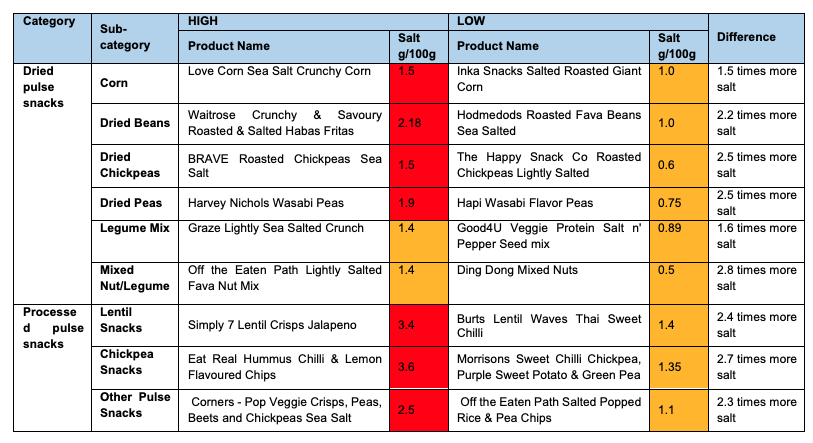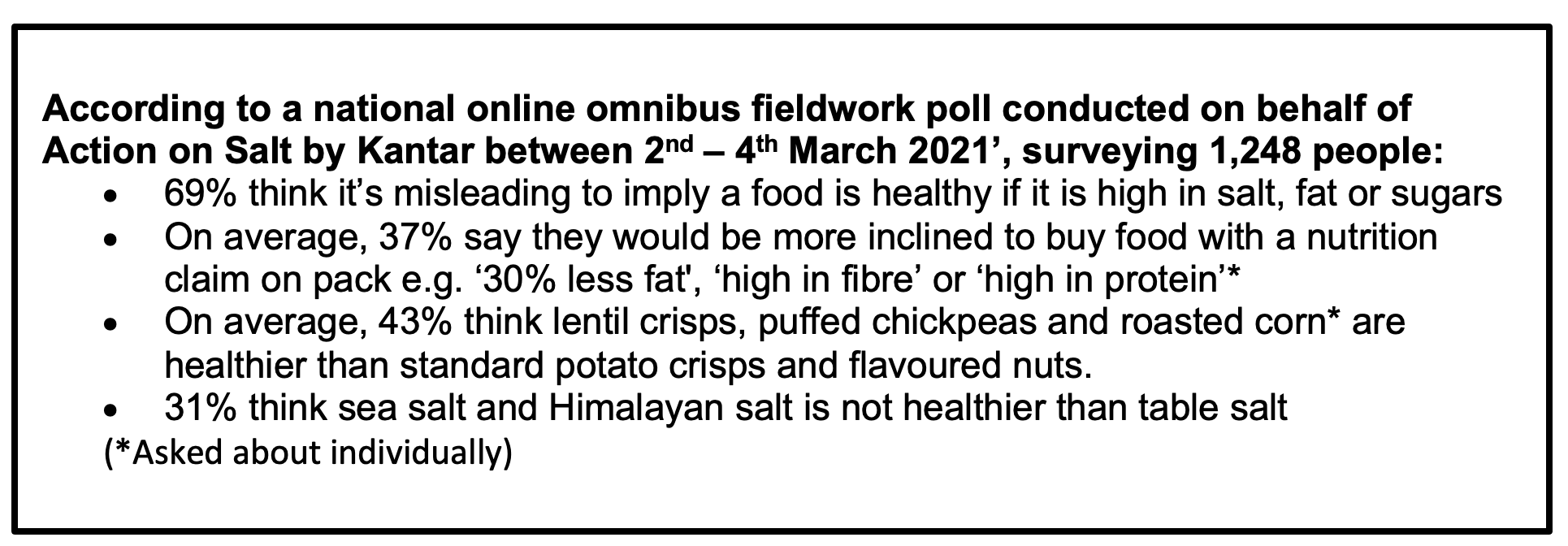Salt Awareness Week Survey
‘Healthy’ Snacks Could Be Sabotaging Our Health as Experts Call for Honest Food Labelling
- Some ‘healthy’ snacks found to be saltier than the concentration of seawater[i] and could be sabotaging our health, say Action on Salt
- New product survey reveals just one 45g serve of Love Corn Habanero Chilli contains more salt than 3.5 bags of Walkers Ready Salted crisps[ii]
- Over half of ‘healthy’ snacks are considered a high fat, salt and/or sugar (HFSS) food, but the majority do not display colour coded labelling on front of pack
- Action on Salt call for a restriction on the use of misleading nutrition claims on foods deemed high in fat, salt and sugar and urge Government to appoint a successor to Public Health England to help bring down salt levels across all food
View the Technical Report: Salt Content in Pulse-based Snacks [PDF 473KB]
To mark Salt Awareness Week (8-14 March), researchers at Action on Salt (based at Queen Mary University of London) are today calling for a restriction on the use of misleading nutrition claims on unhealthy foods (deemed high in fat, salt and sugar: HFSS). This comes as NEW data reveals some seemingly ‘healthy’ snacks are in fact saltier than the concentration of seawater and could be sabotaging our health.
In an analysis of 119 snacks including dried/roasted pulses and processed pulse snacks (lentil curls, chickpea chips and puffs)[iii], which are often perceived as ‘healthy alternatives’ to the usual snacking options (i.e. crisps and flavoured nuts), the findings are raising serious concerns amongst experts – especially given reports of increased snacking during 2020 compared to pre-Covid[iv][v].
Despite these products being (on average) lower in fat, saturated fat and calories, and higher in fibre compared to standard crisps and flavoured nuts, over one in three (43%) are also high in salt (i.e., more than 1.5g/100g) - a forgotten ingredient that raises our blood pressure and puts us at an increased risk of strokes and heart attacks.
The saltiest product surveyed is Eat Real Hummus Chilli & Lemon Flavoured Chips with 3.6g/100g salt, and over 1g salt in a single suggested serve (28g) – more salt than 2 bags of McDonald’s small French fries[vi].
Amongst dried/roasted pulses, corn style snacks were (on average) the saltiest at 1.85g/100g, and more salt than salted peanuts[vii]. The saltiest dried pulse snack surveyed is Love Corn Habanero Chilli, with 2.8g/100g salt – saltier than the concentration of sea wateri. Just one 45g serve of either of this snack (1.3g salt) would provide over a fifth of our maximum daily salt intake[viii] and more salt than 3.5 bags of Walkers Ready Salted crisps[ii]!
Whilst many products are high in salt, the data also presents a wide variation in salt content for different snacks, demonstrating that they can be made with less salt.
Table 1. Examples of products higher and lower in salt for each snack sub-category

Despite more than half (55%) of the products surveyed being high in fat, salt and/or sugar (HFSS)[ix], the majority of products do not display colour coded nutrition information on front of pack as per government guidance[x]. Instead, most products feature on-pack nutrition claims, which, whilst legal, mislead consumers by creating a distorted ‘health halo’ and discouraging shoppers from scrutinising the ingredients more thoroughly.
For example, the saltiest snack surveyed, Eat Real Hummus Chilli & Lemon Flavoured Chips contains 3.6g salt/100g, and yet the front of pack states ‘40% less fat, Vegan, Gluten free’.
81% of snacks surveyed include a nutrient based claim on pack (e.g. ‘x kcal per serving’ ‘Less fat’, ‘No added sugar’, ‘Source/High in fibre/protein’), and almost all (95%) include claims such as ‘Gluten free’, ‘Vegan’, ‘All natural’ and ‘No artificial preservatives’.
One in three snacks surveyed also specify the use of sea salt, which is often perceived as healthier than standard salt, but in fact research[xi] has shown they all contain the same levels of sodium and are therefore equally damaging to health.
What’s more, the Government recently announced plans to restrict the promotion of some unhealthy food[xii] (i.e. only foods which fall under the current sugar and calorie reduction programmes), yet it is not clear whether these snacks will be included in the programme – even though half (55%) of these seemingly healthier products are HFSS. To ensure salt levels are reduced across all products, including so-called ’healthy’ snacks, it is imperative that Ministers announce the successor to Public Health England, to take on their vital salt reduction work.
Sonia Pombo, Campaign Manager at Action on Salt says:
“We should all be eating more beans and pulses, but there are better ways of doing it, and eating processed snacks high in salt is not one of them. This important survey has put a spotlight on the unnecessary amounts of salt in ‘healthy’ snacks, and the use of nutrition claims on HFSS foods need to be questioned. Instead of misleading their customers, companies should be doing all they can to help us all make more informed decisions, including using front of pack colour coded labels.
Professor Graham MacGregor, Professor of Cardiovascular Medicine at Queen Mary University of London and Chairman of Action on Salt says:
“Reducing salt is the most cost-effective measure to lower blood pressure and reduce the number of people suffering from strokes and heart disease. It’s therefore a disgrace that food companies continue to fill our food with so much salt – especially those enticing consumers into purchasing these so-called ‘healthy’ snacks, when they are the exact opposite. For too long the food industry have been in charge of public health, at our expense; it’s time for the Government to take back control."
Mhairi Brown, Policy and Public Affairs Manager for Action on Salt, says:
“This survey brings home how high in salt supposedly ‘healthy snacks’ are: it’s no surprise that we are all eating much more salt than the recommended limit of 6g a day. The UK’s salt reduction programme was once world leading, and countries around the world are looking to us, but it can only be successful if it is properly monitored. This is why we urgently need a replacement for Public Health England - to make our salt reduction programme world leading once more.”
Sheena Bhageerutty, Assistant Nutritionist at Action on Salt adds:
“During lockdown many of us have been reaching for a snack more frequently and are often oblivious to exactly what is in our favourite food. Despite some seemingly ‘healthier’ snack products being on average lower in saturated fat, fat and calories compared to nuts or standard crisps, some are significantly higher in salt. But taste doesn’t have to just mean salt; there are lots of other delicious flavours out there that won’t harm your health.”

ENDS
National PR – David Clarke: david@rock-pr.com M: 07773 225516
Website www.actiononsalt.org.uk
Notes to editors:
About Action on Salt
Action on Salt is a group concerned with salt and its effects on health, supported by 22 expert scientific members. Action on Salt is successfully working to reach a consensus with the food industry and Government over the harmful effects of a high salt diet, and bring about a reduction in the amount of salt in processed foods as well as salt added to cooking, and at the table.
Up to 2011, the UK salt reduction programme, under the Food Standards Agency (FSA), led the world and had already saved 18,000 strokes and heart attacks per year – with £1.5 billion a year in NHS healthcare saving costs, according to NICE.
On 7th September 2020 PHE published a new set of voluntary salt targets for industry to achieve by 2024. However, setting targets without enforcement has been shown to have little effect, as demonstrated by the failed Responsibility Deal and the lack of progress made by the food industry on the previous set of targets. What is required is a clear and transparent monitoring programme, to include annual progress reports and strong engagement with the whole sector, along with case studies of successful reformulation to aid industry-wide reformulation
[i] Atlantic seawater contains 1.0g of sodium per 100g, which equates to 2.5g of salt per 100g
[ii] Walkers ready salted crisps contains 0.35g salt in a 25g bag https://www.tesco.com/groceries/en-GB/products/299913390
[iii] Survey details. Please see Action in Salt’s ‘Salt Contnet of Pulse-based snacks: A Technical Report’ for more detail. Action on Salt surveyed pre-packaged savoury snacks which are often perceived as healthier alternatives to usual snacking options (i.e. crisps and flavoured nuts), available from major retailers; Aldi, Asda, Co-op, Iceland, Lidl, Marks & Spencer, Morrisons, Ocado, Sainsbury’s, Tesco and Waitrose.
Nutrition information was initially obtained in November 2020 from foodDB (a University of Oxford research project funded by the NIHR Biomedical Centre in Oxford) and verified online via retailers’ and manufacturers websites. Additional data was collected from product packaging bought instore using the FoodSwitch Data Collector app on 12th February 2021, and all data was shared with manufacturers and retailers for verification.
[iv] A survey commissioned by EIT, reporting on eating behaviours across Europe found Britons snacked more (27%) than any other European country https://www.eitfood.eu/news/post/eit-food-report-reveals-lasting-impact-of-covid-19-pandemic-on-european-food-behaviours.
[v] Public Health England report Impact of COVID-19 pandemic on grocery shopping behaviours – found increase in volume sales of savoury carbohydrates and snacks (19%) https://assets.publishing.service.gov.uk/government/uploads/system/uploads/attachment_data/file/932350/Grocery_Purchasing_Report.pdf
[vi] A small portion of McDonalds French fries contains 0.44g salt https://www.mcdonalds.com/gb/en-gb/product/fries-small.html
[vii] KP salted peanuts contains 1.3g/100g salt https://www.tesco.com/groceries/en-GB/products/300201309
[viii] Maximum daily intakes for an adult is 6g/day, about a level teaspoon. SACN Salt & Health Report 2003
[ix] Products high in fat, salt and/or sugars (HFSS) are classified by the Department of Health Nutrient Profiling Model (NPM) - foods scoring 4 or more points and drinks scoring 1 or more are classified as HFSS.
[x] Government criteria for colour coding on a front of pack label https://assets.publishing.service.gov.uk/government/uploads/system/uploads/attachment_data/file/566251/FoP_Nutrition_labelling_UK_guidance.pdf.
[xi] In 2011 Action on salt published a survey looking at the sodium content of gourmet salts. http://www.actiononsalt.org.uk/news/surveys/2011/gourmet-salts/
[xii] Currently the proposed restrictions are only taking into account categories included in calorie and sugar reduction programmes, not categories under the salt reduction programme


